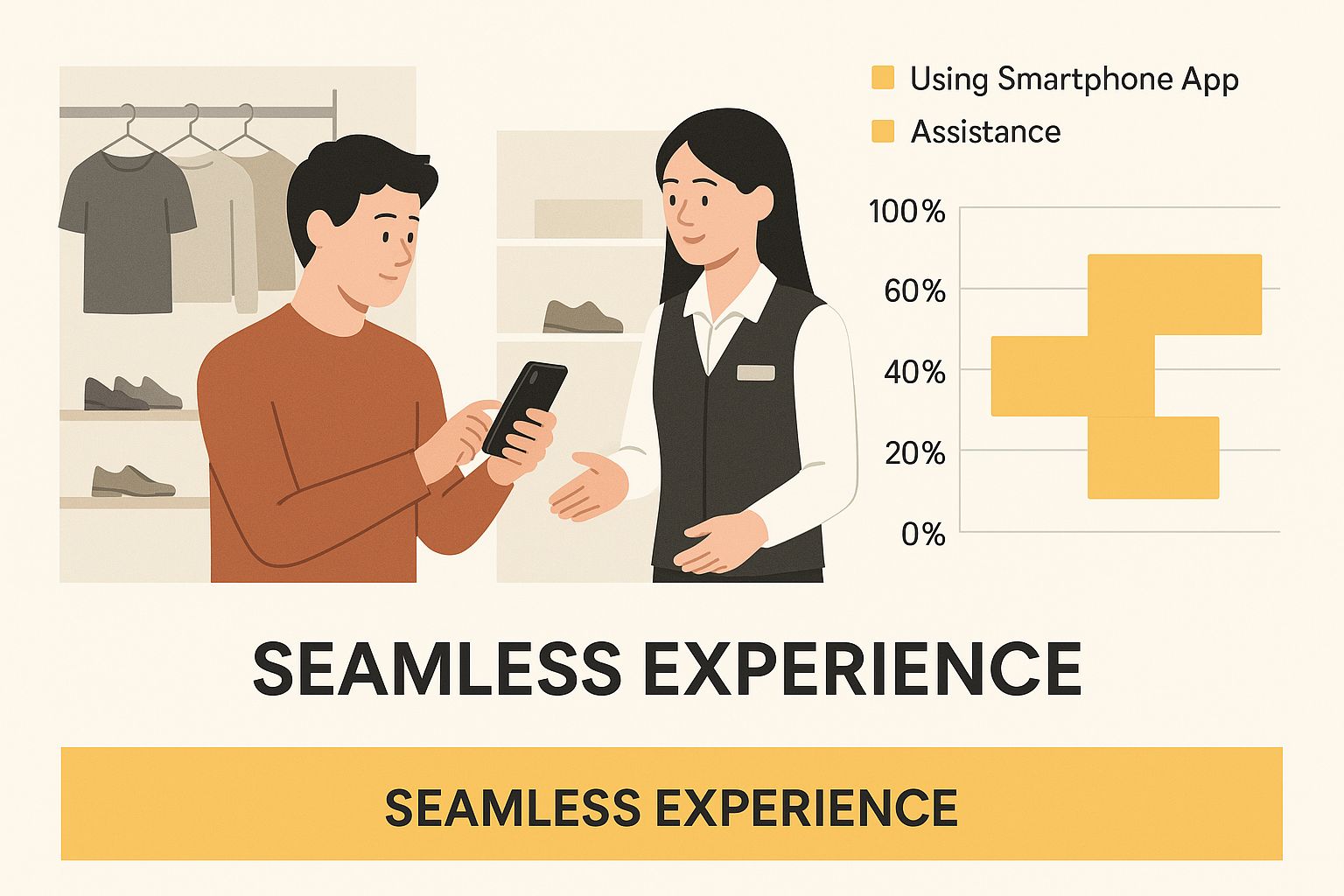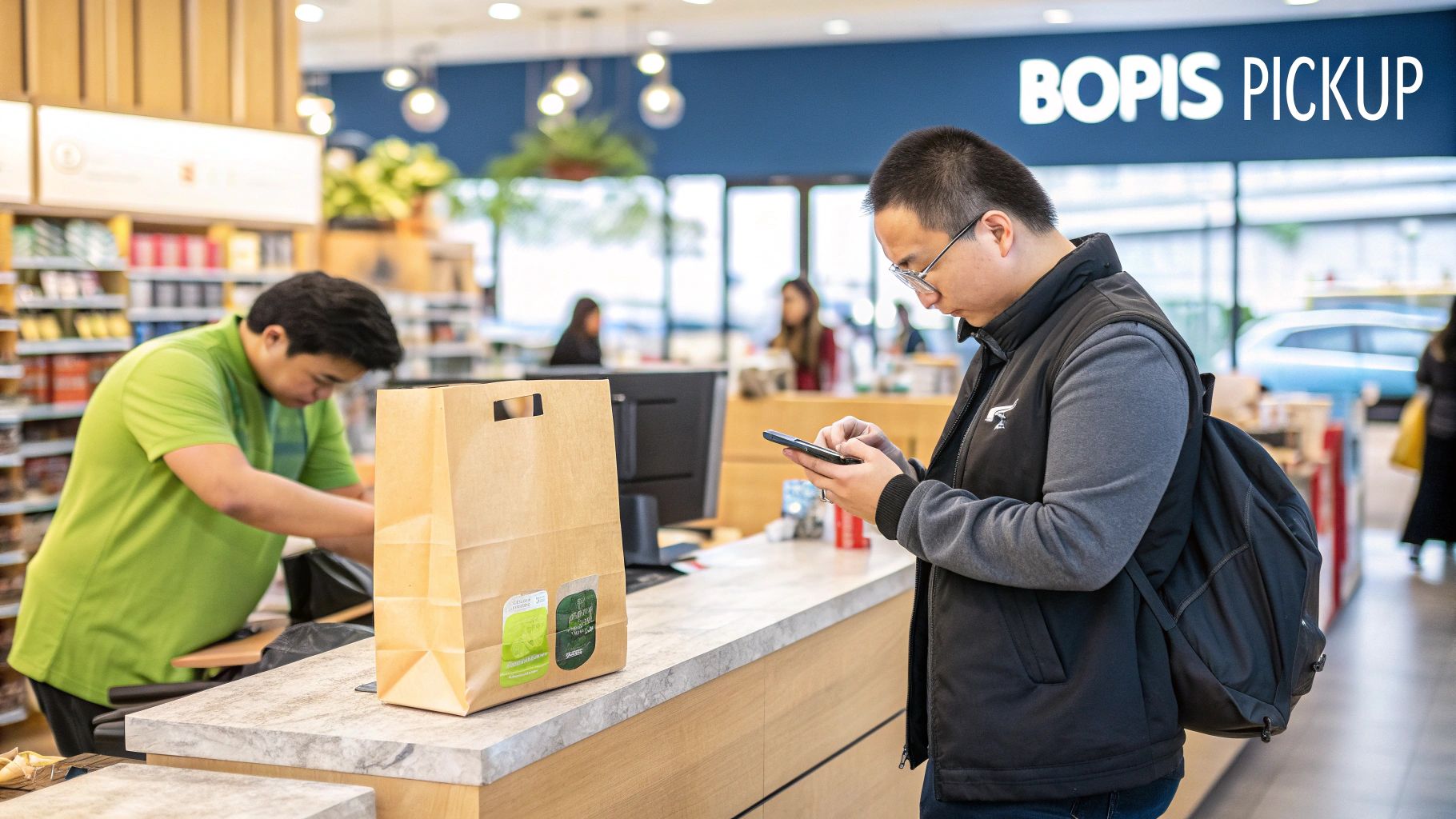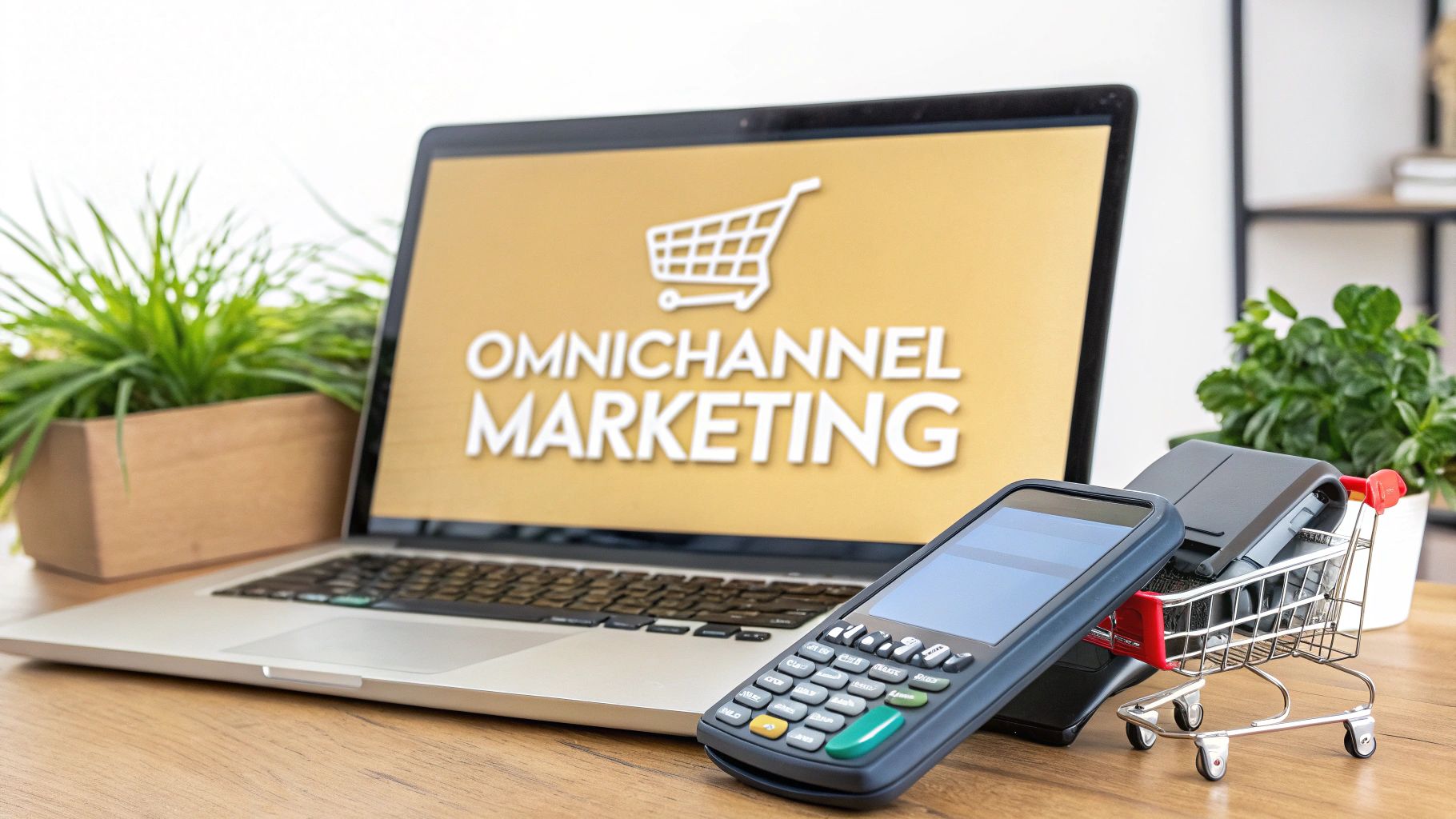At its core, an omnichannel marketing strategy is about creating a single, unified conversation with your customers. It doesn't matter where they interact with you—on your website, in a physical store, or through a mobile app—the experience should feel seamless and connected.
Every interaction should feel like a natural continuation of the last one.
Understanding Omnichannel Marketing Beyond the Buzzword
Let's cut through the jargon for a minute. Imagine you have a personal shopper who remembers your style, knows what you've bought before, and can even anticipate what you might like next. Whether you chat with them online, see them in the store, or get a text about a new arrival, the conversation is always consistent and genuinely helpful.
That’s the essence of an omnichannel approach.
This is a world away from its predecessor, multichannel marketing. To really get what makes omnichannel special, it helps to first understand what multi-channel marketing entails. Think of a multichannel setup like a department store where the salespeople in each section never speak to one another. The shoe department has no idea what the clothing team just sold you, which often leads to a choppy and repetitive experience for the customer.
The Core Philosophy: A Single Customer Journey
The big shift with omnichannel is moving from a channel-focused view to a completely customer-centric one. The goal isn't just to be active on a bunch of different platforms; it's to weave them together so they work in perfect harmony for the customer.
This infographic does a great job of showing what that seamless experience looks like when digital and physical interactions merge.

As you can see, the customer moves fluidly from their smartphone app to an in-store associate, all part of one connected journey. This deep integration is what turns a series of separate touchpoints into a single, cohesive brand experience.
An omnichannel strategy acknowledges that customers don’t see channels; they see one brand. Failing to provide a unified experience means failing to meet modern consumer expectations.
This customer-first mindset is the secret to building real, lasting brand loyalty. Someone might discover your product on Instagram, research it on your website from their tablet, add it to their cart on their laptop, and then decide to pop into a store to pick it up.
An omnichannel strategy makes sure that whole journey is frictionless. Each step recognizes the one before it, making the customer feel understood and valued. And really, that's the ultimate goal. The real power here is building loyalty through convenience and consistency, turning one-time buyers into lifelong fans.
Why an Omnichannel Approach Is No Longer Optional
In today’s world, your customers don’t really see channels. They just see your brand. They expect a single, fluid conversation that moves with them, whether they’re scrolling through your site on their phone during a lunch break or walking into one of your physical stores. If you can’t provide that unified experience, it’s not just a minor inconvenience for them—it’s a direct path to losing their business.
An omnichannel approach isn’t some fancy "nice-to-have" feature reserved for massive corporations anymore. It’s become a baseline expectation. Think about it: when a customer has to re-explain their problem every time they switch from a chatbot to a live agent, it’s frustrating. When an in-store promotion isn’t recognized online, it creates friction. That friction chips away at trust and sends a clear message: you’re not really focused on their experience.
The Financial Impact of a Disconnected Journey
Leaving these gaps in the customer journey is like leaving cash on the table. The proof is right there in the data. A cohesive experience directly translates into higher customer loyalty and, you guessed it, more spending. Customers who engage with a brand across multiple, integrated touchpoints are just flat-out more valuable over their lifetime.
This isn't about fuzzy feelings; it's about driving tangible business results. A solid omnichannel strategy is one of the most powerful levers you can pull to improve the KPIs that actually matter to your bottom line.
Companies with strong omnichannel engagement strategies retain an average of 89% of their customers. Compare that to the dismal 33% retention rate for companies with weak strategies. On top of that, shoppers who buy through multiple channels have a lifetime value that's 30% higher than those who stick to a single channel. You can see the full research on omnichannel shopping statistics from Uniform Market.
This data paints a pretty clear picture. Investing in a connected customer journey pays you back, big time, through better loyalty and bigger spending.
Gaining a Sustainable Competitive Advantage
Beyond the immediate financial wins, adopting one of these omnichannel marketing strategies gives you a serious competitive edge. In a crowded market, a killer customer experience is one of the few things that can truly set you apart. Your competitors can copy your products or match your prices, but it’s a whole lot harder for them to replicate a deeply integrated, customer-first way of doing business.
When you make it easier for people to shop, get help, and connect with your brand on their own terms, you build powerful brand affinity. That kind of loyalty acts like a moat around your business, making your customer base far less likely to jump ship for a competitor's discount.
Here’s exactly how an omnichannel approach boosts your standing in the market:
- Increased Customer Lifetime Value (LTV): A frictionless experience encourages customers to come back more often and spend more over time. It’s that simple.
- Higher Average Order Value (AOV): Seamless cross-channel promotions and smart recommendations—like suggesting an online accessory for an in-store purchase—naturally lead to bigger shopping carts.
- Improved Retention Rates: A consistent and positive experience makes customers feel seen and valued, giving them fewer reasons to even look at your competitors.
- Enhanced Brand Perception: A brand that feels cohesive and reliable everywhere it shows up is seen as more professional, trustworthy, and modern.
Ultimately, the motivation for building an omnichannel framework is crystal clear. It’s about meeting modern consumer demands, unlocking real ROI, and future-proofing your business against competitors who are already making this shift. The question is no longer if you should do this, but how fast you can get it done.
Building the Foundation for Your Omnichannel Strategy

Executing a killer omnichannel marketing strategy isn't something you can just flip a switch on. It needs a solid architectural blueprint before you even think about launching a campaign. Without that groundwork, even your most creative ideas will feel disconnected and fall flat.
Think of it like building a house. You wouldn't start putting up walls without first pouring a solid concrete foundation. In the world of omnichannel, that foundation is built on three non-negotiable components: unified data, a consistent brand experience, and integrated tech.
Create a Single Source of Truth with a CDP
The central nervous system of any true omnichannel setup is a Unified Customer Data Platform (CDP). Its main job is to grab every single customer interaction from every touchpoint—online, offline, you name it—and organize it all into one clean profile.
Imagine this: a customer browses a product on your app, later clicks a social media ad for that same item, and then walks into your store to ask a question. Without a CDP, those are just three random, isolated events. With a CDP, they become a single, understandable story about one person's journey, giving you the context you need for truly personal interactions.
This central data hub lets you:
- Track the complete customer journey across every single channel.
- Segment audiences with incredible precision based on what they're doing right now.
- Personalize messaging by actually understanding a customer's full history with your brand.
Without this single source of truth, you're basically flying blind, guessing at how customers are engaging with you across different platforms.
A Customer Data Platform doesn't just store data; it translates scattered interactions into a coherent narrative. This narrative is the key to making every customer feel recognized and understood, no matter how they choose to connect with your brand.
Ensure a Consistent Brand Experience Everywhere
Consistency is the bedrock of trust. A real omnichannel strategy demands that your brand’s voice, visual identity, and core message feel the same whether a customer is reading an email, scrolling your Instagram feed, or chatting with a support agent.
This goes way beyond just using the same logo and colors. It's about making sure the feeling of your brand is the same everywhere. If your online voice is fun and informal, your in-store staff shouldn't be rigidly formal. If your app is designed to be super user-friendly, your website checkout can't be clunky and confusing.
Inconsistencies create friction and wreck the seamless experience you’re trying to build. Customers should feel like they're dealing with one single company, not a bunch of disconnected departments. For a deeper dive, our guide on how to improve customer experience has some great insights that fit right in here.
Integrate Your Technology Stack Seamlessly
Finally, your foundation needs the right technological plumbing to make it all work. Your different systems—like your Customer Relationship Management (CRM), e-commerce platform, and Point of Sale (POS) system—can't operate in their own little silos. Seamless tech integration is what lets data flow freely between them.
When your tech is integrated, honestly, magical things can happen. For example:
- An in-store purchase gets logged by your POS system and instantly updates the customer’s profile in your CRM.
- That update triggers a personalized "thank you" email with a relevant product recommendation.
- The customer’s loyalty points are automatically synced between their online account and in-store profile.
This free-flowing data eliminates internal silos and lets your teams work from a single, unified view of the customer. It’s the final and most critical piece of the puzzle, turning the idea of an omnichannel journey into a functional reality.
Proven Omnichannel Marketing Strategies You Can Implement
 Alright, once you've got the basics down, it's time to put some real omnichannel marketing strategies to work. These aren't just buzzwords or theories—they're practical, road-tested tactics that create the kind of seamless experience modern customers actually expect.
Alright, once you've got the basics down, it's time to put some real omnichannel marketing strategies to work. These aren't just buzzwords or theories—they're practical, road-tested tactics that create the kind of seamless experience modern customers actually expect.
The whole point is to make every interaction feel like the next logical step in a single, ongoing conversation with your brand. Each of these strategies is designed to bridge the gap between your different channels, turning separate touchpoints into one cohesive journey that boosts engagement and builds real loyalty.
Merge Digital and Physical with BOPIS
One of the clearest examples of omnichannel in action is the Buy Online, Pick-up In-Store (BOPIS) model. It's the perfect marriage of e-commerce convenience and brick-and-mortar speed. Someone can browse your entire inventory from their couch, click "buy," and then swing by your store to grab their order, sometimes on the same day.
But it's more than just a convenience play. BOPIS gets people into your physical store, opening the door for impulse buys and extra sales. It also helps you manage inventory more efficiently and cuts down on shipping costs.
The success of BOPIS hinges on perfect technological harmony. Your e-commerce platform must have real-time communication with your in-store inventory management system to prevent selling items that aren't actually available for pickup.
Use Data to Drive Hyper-Personalization
Real personalization is so much more than sticking a first name in an email. A solid omnichannel strategy uses unified customer data to craft experiences that are genuinely relevant, because they're based on a customer's entire history with your brand. Every interaction is informed by the last one, no matter where it happened.
Think about this classic scenario:
- A customer adds a pair of running shoes to their online cart but gets distracted and leaves.
- An hour later, an automated email lands in their inbox, gently reminding them about the shoes.
- The next day, while scrolling Instagram, they see an ad for those exact shoes, maybe even paired with a glowing customer review.
That’s not a coincidence; it's a carefully orchestrated journey fueled by data. This kind of personalization shows you're paying attention and makes your marketing feel less like an ad and more like a helpful nudge. At its core, omnichannel is about constantly improving how customers interact with you. Good customer experience optimization strategies ensure every touchpoint is smooth and satisfying, which is what builds loyalty.
Create an Integrated Loyalty Program
Your customer loyalty program shouldn't be stuck on one channel. An integrated program lets customers earn and redeem rewards effortlessly, whether they’re shopping on your mobile app, your website, or standing in your store. It's a powerful way to encourage people to engage with you across multiple platforms.
For example, a customer could rack up points from an online purchase and then use them for a discount in-store just by giving their phone number. This frictionless system makes the rewards feel more valuable and easier to use—a key ingredient for a successful program.
And the data backs this up. Campaigns that use three or more channels see a 287% higher purchase rate compared to single-channel campaigns. That's a massive difference.
Build a Unified Customer Support System
Nothing frustrates a customer faster than having to repeat their problem every single time they switch support channels. A unified customer support system is a non-negotiable part of a great omnichannel strategy. It lets the conversation flow from one platform to another without losing any context.
This means a customer can start with a chatbot on your site, get handed off to a live agent, and then follow up via email the next day—all without having to explain their issue over and over. The support agent sees the entire conversation history and can pick up right where the last interaction left off.
This doesn't just solve problems faster; it dramatically improves how customers see your brand. A seamless support system is a huge driver of brand loyalty and is central to figuring out how to improve customer engagement everywhere.
Seeing Omnichannel Marketing in the Wild
Theory is great, but seeing how the big players pull off omnichannel marketing strategies in the real world is where the lightbulbs really go on. It’s one thing to talk about a seamless experience; it’s another to see it in action. So, let's break down the customer journeys built by two brands that have turned this concept into an art form: Disney and Starbucks.
These aren't just case studies; they're blueprints for creating unforgettable, unified customer experiences. They prove that when you get the tech, data, and a customer-first mindset working together, the results feel like magic.
Disney: The Magic of a Truly Connected Experience
Disney’s approach to omnichannel is the stuff of legend because it’s all about removing friction to crank up the fun. The heart of their entire strategy is the MagicBand, a simple wristband that becomes a guest's key to everything in the Walt Disney World ecosystem. It’s the ultimate bridge between their digital planning and their physical adventure.
Think about a typical family's journey:
- Planning at Home: Months before they even pack, they’re on the My Disney Experience website or app. They're booking the trip, making dinner reservations, and scheduling FastPass+ ride times. All that information gets tied directly to their profile.
- Arriving at the Park: That MagicBand is their park ticket. It unlocks their hotel room door. It’s also linked to all their FastPass+ reservations, so they can forget about juggling paper tickets or keys.
- During Their Stay: When a park photographer snaps a picture, it's automatically sent to their account through the band. If they want to buy a snack or a souvenir, they just tap the band to pay, charging it right to their room.
This seamless flow means guests spend way less time fumbling with logistics and more time soaking in the experience. Every touchpoint is smooth, connected, and reinforces that feeling of "magic" Disney is famous for.
The genius of Disney’s omnichannel strategy is that it’s almost invisible to the guest. The technology just works quietly in the background, orchestrating a frictionless journey that makes everything feel effortless.
By weaving every part of the trip together—from planning to payment—Disney doesn't just sell a vacation. It curates a memorable story that builds a deep, lasting connection to its brand.
Starbucks: A Masterclass in Mobile Integration
While Disney nails the physical-digital blend in a resort, Starbucks has perfected it for our daily grind. The Starbucks app is the engine of its omnichannel strategy, turning a simple coffee run into a personalized and super-efficient experience that keeps millions of people coming back.
The app is so much more than a digital menu. It’s a powerful little ecosystem that pulls several key functions together flawlessly:
- Mobile Ordering & Payment: Customers can order and pay before they even walk in the door, completely skipping the line. That convenience alone is a huge driver of loyalty. In fact, mobile orders have recently accounted for over 30% of U.S. company-operated sales.
- Integrated Rewards Program: Every single purchase made through the app automatically earns "Stars" toward free drinks and food. The program is dead simple to use, and you can watch your progress in real-time, which definitely encourages one more visit to get that reward.
- Personalized Offers: The app pays attention. It uses your purchase history to send you customized offers and suggest new things you might actually like. It remembers your "usual" order, making it a one-tap process to get your favorite drink started. It makes you feel like they know you.
Starbucks figured out early that for most of us, our phone is our primary connection to the world. By building a rock-solid app that mashes up convenience, rewards, and personalization, they created a tool that not only makes their stores run smoother but also builds a direct, ongoing relationship with each customer. It turns a daily habit into a loyal ritual.
How to Measure the Success of Your Omnichannel Efforts
So you’ve rolled out a slick omnichannel strategy. That’s a fantastic start, but now for the million-dollar question: is it actually working? Proving its value means looking beyond the usual suspects. You have to shift from isolated, channel-specific numbers to bigger-picture KPIs that show the whole customer journey.
Traditional metrics like email open rates or social media likes still have their place, but they don't tell the full story. The real measure of omnichannel success is how well you keep customers around and increase what they're worth to you over time, no matter how they choose to connect with your brand.
Key Performance Indicators for Omnichannel Success
To really get a handle on your ROI, you need to track metrics that reflect the seamless experience you’re trying to build. These KPIs cut through the noise and show you the real impact on your bottom line.
Here’s where I’d recommend starting:
- Customer Lifetime Value (LTV): This is the big one. If your LTV is climbing, it’s a clear sign that your integrated experience is making customers stick around longer and spend more. It’s the ultimate report card.
- Customer Retention Rate: A great omnichannel strategy makes people feel seen and understood, which gives them very few reasons to look elsewhere. This metric is a direct reflection of loyalty and satisfaction.
- Cross-Channel Conversion Rates: This is where things get interesting. You need to track how many people start their journey in one place (like a social ad) and finish it somewhere else (like your website or even in-store).
These metrics give you a high-level view of whether your strategy is building the kind of long-term relationships that lead to real, sustainable growth. It's about looking past single-campaign wins to gauge the overall health of your business.
An omnichannel approach isn't just about being everywhere; it's about making every interaction count. Your measurement strategy should reflect this by focusing on the overall customer relationship, not just individual touchpoints.
Understanding Touchpoint Contribution with Attribution
One of the trickiest parts of measuring omnichannel is figuring out which touchpoints actually nudged a customer toward a purchase. This is where attribution modeling becomes your best friend. Instead of just giving all the credit to the last click, attribution helps you assign value to every little interaction along the way.
Good attribution shines a light on the assists—those channels that influence a purchase even if they don't get the final glory. If you want to dive deeper, check out our guide on what marketing attribution is and how to put it to work. By analyzing the entire path, you can start making smarter, data-backed decisions on where to put your marketing dollars for the biggest impact.
Your Omnichannel Questions, Answered
Even when you have a solid plan, a few questions always pop up. Let's tackle some of the most common ones we hear from businesses making the jump to omnichannel.
Omnichannel vs. Multichannel Differences
So, what’s the real difference between omnichannel and multichannel marketing? It really boils down to your focus. Multichannel is about getting your message out on a bunch of different platforms, but they don't really talk to each other—they're more like separate conversations happening in different rooms.
Omnichannel, on the other hand, connects all those rooms. It puts the customer at the center of everything, creating one continuous, seamless experience no matter where they interact with you. With multichannel, the channel is the hero; with omnichannel, the customer is.
Omnichannel for Small Businesses
Can a small business actually pull off an omnichannel strategy? Absolutely. You don’t need a giant marketing budget to make this work. The key is to start small and be smart about it.
Pick your two or three most important channels—maybe your website, email list, and Instagram account—and focus on integrating those first.
The goal isn't to be everywhere at once. It's to build a unified journey for your customers where it matters most, creating a consistent experience and using shared data to make every interaction feel more personal.
The Biggest Implementation Challenge
What's the one thing that trips most businesses up? Hands down, it's data integration. Most companies have their customer information scattered across different systems that don't communicate—a CRM here, an e-commerce platform there, and a point-of-sale system over yonder.
Getting past this hurdle requires a clear tech plan. Often, this means bringing in a Customer Data Platform (CDP) to act as a single source of truth for all your customer data. When your whole team is working from the same unified customer view, you can finally make that seamless experience a reality.
At Up North Media, we specialize in building the data-driven foundations and web applications necessary for powerful omnichannel success. Schedule a free consultation to learn how we can help you accelerate growth.
